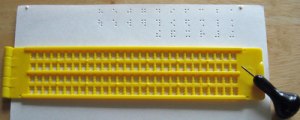Thirty years ago when computer technology came to the fore, the thinking was that it would liberate the heretofore braille-bound reader from the shackles of outmoded, bulky, and pedestrian forms of reading and writing—especially that lowly-of-low slate and stylus. What? Learn to write braille BACKWARDS?
Well, I’m as computer-literate as the next person, but I still keep my secret stash of slates. Indeed, I keep adding to it, covertly, clandestinely, cryptically. As a co-owner of Tactile Vision Graphics, my slate and stylus remains an essential business tools. It’s no lower than a pen and paper, which I notice people still carry around, and for the same purposes:
• It identifies business cards
• Labels file folders
• Jots down phone numbers and addresses on the run
• Makes an excellent signature guide
• Braille's Welsh flash cards for my evening classes
• Takes notes when the Braille Note Apex isn’t handy
• Marks a conference leaflet for future reference
• Sends braille notes to vision-impaired customers.
So, I say, All praise to the lowly metal or plastic “pencil and paper for the blind!” No technology has yet come close to matching its versatility or universality—and it never requires beta-testers or a software update!
Rebecca Blaevoet and her husband, Emmanuel, co-own Tactile Vision Graphics in Ontario, Canada.

